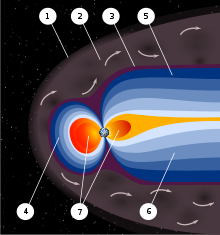Plasma sphere
The plasma sphere is the inner part of the terrestrial magnetosphere that is closed to form a torus and is filled with a relatively cool plasma , T = 6000 to 35,000 K, made up of electrons and mainly protons (H + ).
The outer boundary of the plasma sphere is the so-called plasma pause , which is characterized by a rapid decrease in plasma density . In the direction of the sun , the plasma pause is at a height of about four earth radii , on the night side at about 6 to 7 earth radii. There plasma is lost in the direction of the magnetic tail. These losses are replaced by the ionosphere , the continuation of which is the plasma sphere. This happens parallel to the field lines , starting from high latitudes.
The decrease in electron density beyond the F layer of the ionosphere is exponential, initially with a scale height corresponding to the decrease in the concentration of ionized atomic oxygen (O + ), then following the slower decrease in H + . The transition altitude at around 1000 km is sometimes somewhat arbitrarily defined as the upper limit of the ionosphere.
The plasma sphere, or more precisely: the break in the electron density at the plasma pause, was discovered by Don Carpenter in 1963 during the analysis of Whistlers .
Originally, the plasma sphere was viewed as a well-formed, cold plasma, whose particle movement is completely determined by the earth's magnetic field and therefore corotates with the earth. In contrast, recent satellite observations have shown that density irregularities such as clouds or imperfections can form. It was also shown that the plasma sphere does not corotate continuously with the earth.
See also
Individual evidence
- ↑ Stefan Heise: Reconstruction of three-dimensional electron density distributions based on CHAMP-GPS measurements . FU Berlin, 2002, Chapter 2: The Earth's Ionosphere and Plasma Sphere , urn : nbn: de: kobv: 188-2002002731 ( fu-berlin.de [PDF] Dissertation).
- ↑ J. Lemaire, KI Gringauz, David L. Carpenter, V. Bassolo: The earth's Plasmasphere . Cambridge University Press, 2005, ISBN 978-0-521-67555-0 (English).
literature
- DL Carpenter: Whistler evidence of a 'knee' in the magnetospheric ionization density profile . In: J. Geophys. Res. Band 68 , 1963, pp. 1675-1682 (English).
- A. Nishida: Formation of plasmapause, or magnetospheric plasma knee, by combined action of magnetospheric convections and plasma escape from the tail . In: J. Geophys. Res. Band 71 , 1966, pp. 5669 (English).
- BR Sandel, et al .: Extreme ultraviolet imager observations of the structure and dynamics of the plasmasphere . In: Space Sci. Rev. Band 109 , 2003, p. 25 (English).
Web links
- NASA website
- University of Michigan: Description
- University of Alabama, Huntsville: Plasmasphere Research ( June 9, 2010 memento in the Internet Archive )
- Southwest Research Institute: Description
- IMAGE Extreme Ultraviolet Imager
- EUV images of the plasma sphere

